Table of Contents
If your ankle hurts during squats, prepare to have your mind blown!
Does ankle pain during squatting require driving more ankle mobility?
But what if you have a full squat?
That is what we run into in today’s case study. Here, we assess the entire body to see all the factors that contribute to this particular client’s ankle problem, and devise a solution WITHOUT ANY ANKLE MOBILITY DRILLS.
Check out the video and case summary below to see what we did!
Case overview
It’s Kevin again. You might remember him from our first case study where he was dealing with shoulder pain.
Since our last session, he actually had a solid improvement on active motion and was keeping up with his moves 4 times per week.

Kevin, three months later, is now coming to me complaining of left medial ankle pain that he may have injured snowboarding. He notices issues with the following movements:
- Deep squatting
- Olympic lifts
- Heel raises/triple extension
I did a screening examination and didn’t find any swelling or tenderness to palpation. I checked for fractures with a tuning fork test and did some neurodynamic testing to no avail.
From there, it was into the standard evaluation, while looking at some ankle range of motion.
Objective findings
Here were Kevin’s initial findings from this session. His measures from 3 months ago are in parentheses.
| Test | Left | Right |
| Infrasternal angle | wide | |
| Shoulder flexion | 85 (0) | 80 (0) |
| Shoulder external rotation | 90 (85) | 90 (85) |
| Shoulder Internal rotation | 90 | 90 |
| Hip flexion | 110 (95) | 110 (95) |
| Hip external rotation | 60 | 45 |
| Hip internal rotation | 40 | 45 |
| Straight leg raise | 75 (65) | 75 (65) |
| Hip extension/adduction | 0 (-10) | 25% (-10) |
| Lower cervical rotation | + | + |
| Squat | pain | |
| Knee extension | -3 | -7 |
| Ankle dorsiflexion | 10 | 20 |
| Ankle plantarflexion | 30 | 40 |
| Ankle Inversion | 50 | 45 |
| Ankle Eversion | 5 | 3 |
| Big toe extension (ankle PF) | 15 | 15 |
| Big toe extension (ankle DF) | 15 | 15 |
As you can see, Kevin has made several improvements since our last session. That shoulder flexion is like whoa!
But we broke out the ankle a bit this time, and there are a few things to note here:
- Has large amounts of eversion on the left
- Limited left plantarflexion
Take that into consideration with his foot posture:
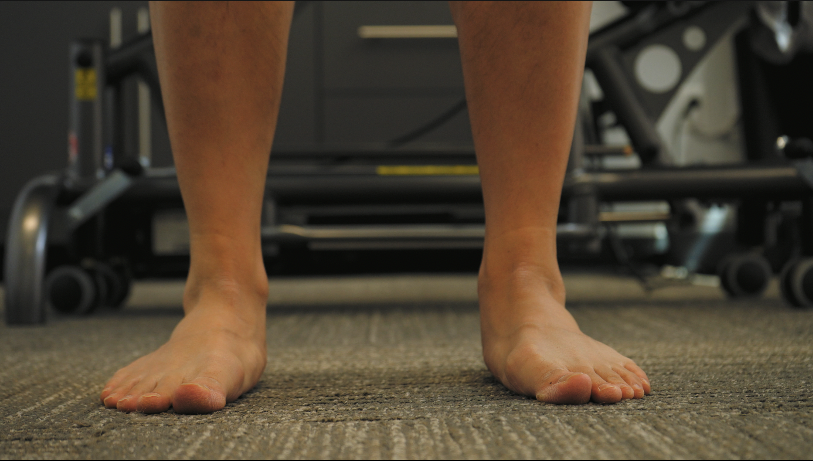
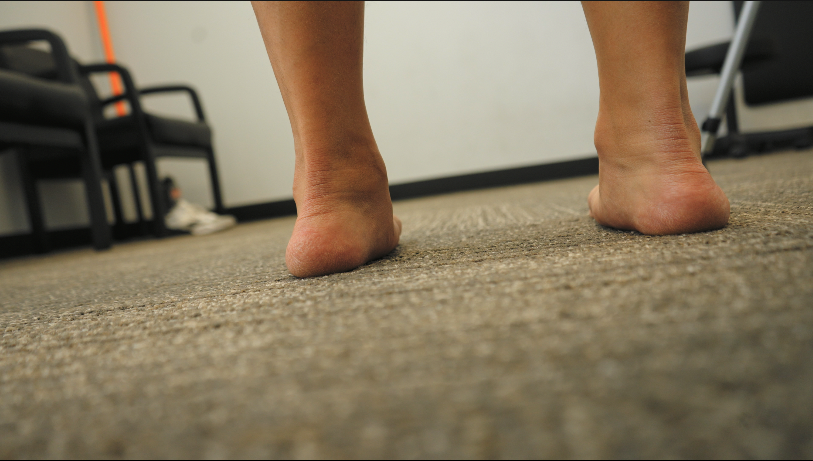
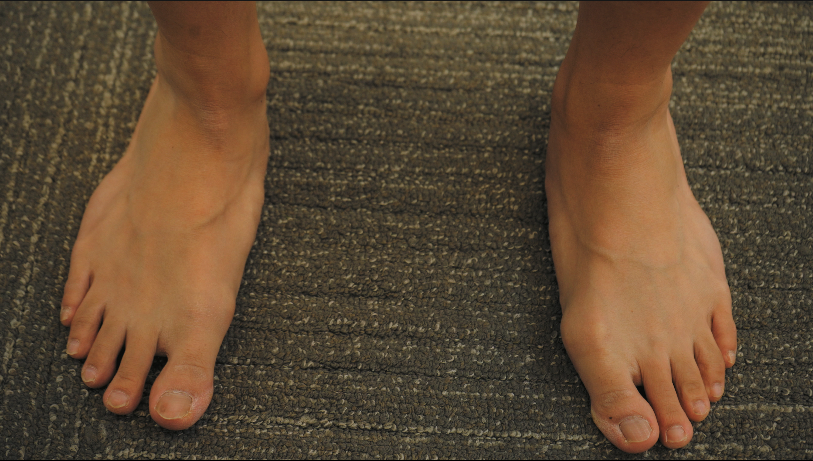
You can see in the pics above that Kevin’s feet are fairly flat, and appear this way as well when nonweightbearing.
What’s likely happening is that when internal rotation demands occur in the squat, which are high since Kevin is a wide infrasternal angle (ISA), Kevin creates most of this action by everting the calcaneus and pronating the foot (an eccentric position in the medial ankle). Perhaps, given the left internal rotation loss on the left, the medial ankle is where he picks up that motion.
But wait, Zac. Kevin has full left hip internal rotation, what gives?
I’m GLAD you asked!
You have to look at the following things:
- Left ankle dorsiflexion
- Right hip external rotation
The dorsiflexion loss indicates an internal rotation deficit, but surprisingly so does the right hip external rotation loss.
You see, in a wide ISA presentation, we would expect a loss of external rotation bilaterally, with internal rotation approaching a normal range of 40º.
Here, we see something different. We see full external rotation on the left, and a magnification of internal rotation on the right. This is a subtle presentation but indicates a right oblique axis in the pelvis. A right oblique orientation presents typically as follows:
| TEST | LEFT | RIGHT |
| Straight leg raise | more | less |
| Hip external rotation | more | less |
| Hip internal rotation | less | more |
Kevin presents with this based on the right hip external rotation deficit.
Intervention selection
Given the findings above, the big focus for Kevin will be as follows:
- Turn the pelvis left to counteract right oblique axis
- Restore knee/ankle motion and drive appropriate foot contacts.
Let’s see if we can nail it with a few moves:
Left offset hooklying tilt with left hip shift
I chose this move to work on teaching my dude to turn to the left. The shift coupled with left inside heel contact helps him internally rotate from a more externally rotated position.
Interestingly enough, Kevin was getting some left hamstring cramping during this move. Cramping indicated that the internal rotation demands were too great, so his hams got baconed.
I initially tried to use heel wedges to lessen the internal rotation demands, but something interesting happened here; Kevin couldn’t place his first metatarsal heads on the ground. This compensation illustrated the extent of how pronated his feet were; enough that he couldn’t supinate his foot much at all.
What I ended up settling on was a left foot elevated tweak to the above move. This helped offload the weight on the left side, which eliminated the cramping. He was also able to put his foot flat on the ground!
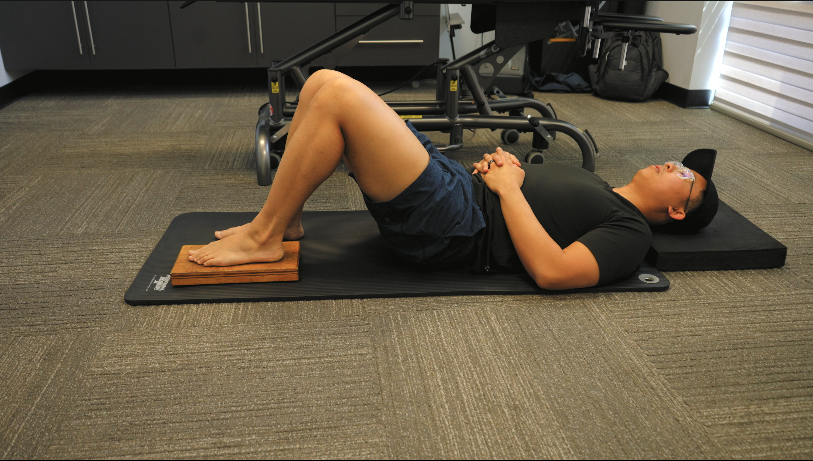
After performing this move, Kevin’s test results were as follows (improvements are bolded; worse is italicized):
| Test | Left | Right |
| Infrasternal angle | wide | |
| Shoulder flexion | 120 (+35) | 120 (+40) |
| Hip flexion | 115 (+5) | 120 (+10) |
| Hip external rotation | 60 | 55 (+10) |
| Hip internal rotation | 40 | 45 |
| Straight leg raise | 80 (+5) | 80 (+5) |
| Hip extension/adduction | -5 (-5) | 50% (+25%) |
| Squat | pain | |
| Knee extension | -3 | -7 |
| Ankle dorsiflexion | 10 | 20 |
| Ankle plantarflexion | 40 (+10) | 40 |
| Ankle Inversion | 50 | 45 |
| Ankle Eversion | 5 | 5 (+2) |
| Big toe extension (ankle PF) | 15 | 15 |
| Big toe extension (ankle DF) | 20 (+5) | 15 |
Overall, some decent improvements, but the continual right hip external rotation deficit indicated a greater need to turn Kevin to the left. Moreover, the squat in standing was still painful. This finding led me to believe I may have needed something that was more weight-bearing to drive more positive change.
Left lateral squat with left foot elevation
I chose this move because the abduction is going to drive the external rotation action needed on the right to turn the pelvis left. Kevin had to maintain heel contact on the left to prevent going into excessive pronation while superimposing the hip internal rotation needed on that left side.
Here were the results:
| Test | Left | Right |
| Infrasternal angle | wide | |
| Shoulder flexion | 145 (+25) | 120 |
| Hip flexion | 125 (+5) | 120 (+5) |
| Hip external rotation | 60 | 60 (+5) |
| Hip internal rotation | 40 | 45 |
| Straight leg raise | 80 | 80 |
| Hip extension/adduction | 0 (+5) | 75% (+25%) |
| Squat | Less pain | |
| Knee extension | -5 (+2) | -7 |
| Ankle dorsiflexion | 10 | 20 |
| Ankle plantarflexion | 40 | 40 |
| Ankle Inversion | 50 | 45 |
| Ankle Eversion | 5 | 5 |
| Big toe extension (ankle PF) | 15 | 15 |
| Big toe extension (ankle DF) | 20 | 15 |
Boom! Our first symptom change on the squat, and we restored the external rotation. With hip mobility improved, I opted to work distally to see if I could improve left internal rotation even further.
The limitation that stood out to me next was knee extension, an internal rotation measure.
Terminal knee extension (manual and exercise)
Considering that Kevin was getting pain coming out of the bottom of the squat and with heel raises, the knee extension deficit was an easy spot to attack.
I drove this action manually while biasing tibial internal rotation. Though conventionally, knee extension is associated with tibial external rotation, I opted to bias internal because that movement was restricted.
Here were the test results afterward:
| Test | Left | Right |
| Infrasternal angle | wide | |
| Shoulder flexion | 145 | 120 (+5) |
| Hip flexion | 125 | 130 (+5) |
| Hip external rotation | 60 | 60 |
| Hip internal rotation | 40 | 45 |
| Straight leg raise | 80 | 80 |
| Hip extension/adduction | 0 | 75% |
| Squat | NO PAIN! | |
| Knee extension | -5 | -7 |
| Ankle dorsiflexion | 10 | 20 |
| Ankle plantarflexion | 40 | 40 |
| Ankle Inversion | 50 | 45 |
| Ankle Eversion | 5 | 5 |
| Big toe extension (ankle PF) | 15 | 15 |
| Big toe extension (ankle DF) | 20 | 15 |
By far a big win symptom-wise!
I then reinforced it with an active strategy
Post-treatment debrief and recommendations
Overall, I was pleased with the changes that we got in this session. The key was driving the left turn proximally, then cleaning things up distally For the most part, we got some really nice changes.
However, given Kevin’s activity levels, I didn’t think these moves were going to solve all our problems. I also made some other recommendations to assist in Kevin returning back to full Olympic lifting without issues.
Shoewear
Kevin likes to wear zero-drop shoes and flats. However, these shoes are given his foot presentation.
The flatness of the zero-drop shoes will drive more dorsiflexion, eversion, and pronation, which may further contribute to him utilizing the pronated foot strategy. Moreover, Kevin has like…uh…no big toe extension, fam. So a flexible toe box is not going to help us out either.
Conservatively, I recommended he switch to a more supportive shoe with a stiff toe box. Hokas are a great choice here. A more aggressive option would be an orthotic that limits big toe extension, but the Hokas were a reasonable starting point.
Training recommendations
Given that Kevin was moving pretty well compared to our initial session, I didn’t think we needed a major training overhaul. Though I did want Kevin to employ some higher-level tactics to reinforce positions.
Below are the recommendations I made for the lower body, all of which get the pelvis facing left and drive a leftward turn:
- Left lateral squat with a right arm load
- Right split squat with a right arm load
- Left TRX single leg squat to box
- Right step up with a right arm load
In terms of heavier loads, I thought I safety squat bar box squat would be just fine as we could keep internal rotation gains:
Upper body-wise, I wanted him to incorporate the following:
- Single-arm push press with head turn (to drive end-rage upper thorax rotation)
- alternating lat pulldowns (to increase lower ribcage dynamics)
With these recommendations, I’m hoping that Kevin can return to Olympic lifting pain-free, and get back to competing!
How do you improve ankle pain during squats? Comment below and let the fam know!
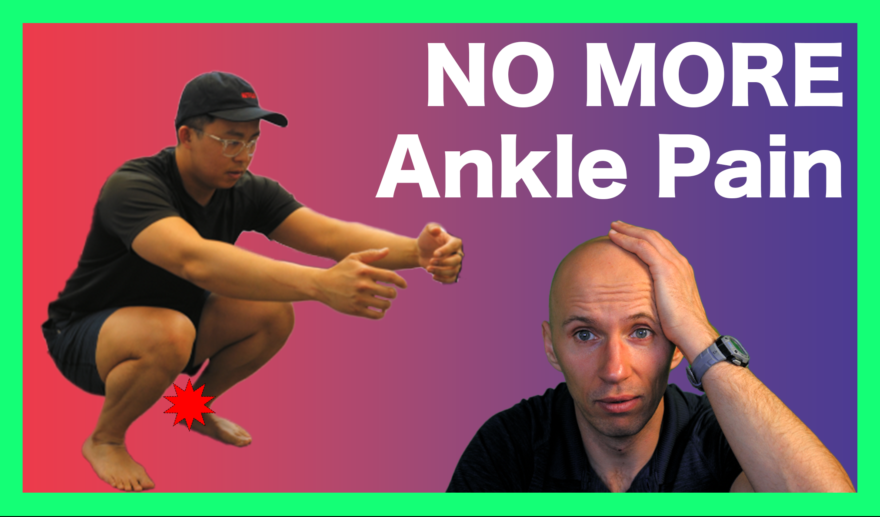
Great post. With the single arm push press with head turn is the intent to decrease compression to upper DR to increase shoulder flexion on the left? Measurements in the post has right shoulder flexion Less than left. Or was the video not specific to measurements in the post?
Head turn is to encourage rotation down to T5.
If I head turn left, I’ll get:
– Left posterior expansion
– Right anterior expansion.
Does that clarify?